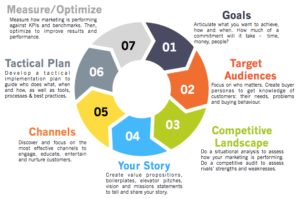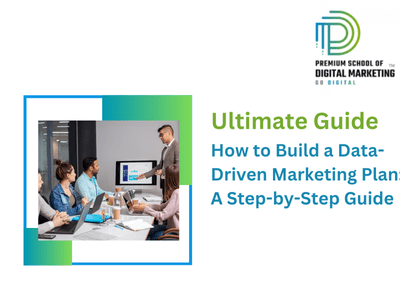Table of Contents
introduction
In today’s competitive landscape, simply running campaigns isn’t enough—brands need to make informed decisions backed by data. A data-driven marketing plan is essential to optimise your strategy, ensure better ROI, and make smarter business decisions. Understanding your audience and adjusting campaigns based on real-time insights can position your brand for success.
Whether you’re just starting or have experience in digital marketing, learning how to build a data-driven strategy can significantly boost your Digital Marketing skills. This article will guide you through building a successful data-driven marketing plan, step by step.
Why is a Data-Driven Marketing Plan Essential?
Digital marketing is rapidly evolving. Today’s consumers are more informed and connected than ever, so businesses need a targeted approach to reach them effectively. A data-driven strategy ensures that every marketing decision is backed by insights, from audience behaviour to campaign performance.
With the digital marketing industry booming, professionals equipped with data-analysis skills are in high demand. Whether you’re looking for Digital marketing courses in Pune or Digital marketing courses in Vashi, now is the perfect time to upskill and stay ahead of the competition. Learn the ropes at the School of Digital Marketing, where experts train you to create high-performing strategies.
Step 1: Set Clear Goals with Data-Backed Insights
Before you dive into any marketing efforts, set specific and measurable goals. Your objectives should align with your overall business goals and be SMART (Specific, Measurable, Achievable, Relevant, and Time-bound).
For example:
- Increase website traffic by 20% in the next quarter using SEO strategies.
- Generate 50% more leads through paid social media ads in six months.
Data to Use: Analyze past campaign performance, audience engagement data, and conversion rates to determine realistic goals.
A solid foundation begins with clarity. At the School of Digital Marketing, we teach you to set achievable, data-driven goals for success, whether you’re based in Pune, Vashi, or anywhere else.
You may also like to read: Case Study: Successful Digital Marketing Campaigns From Pune Businesses
Step 2: Understand Your Audience Using Analytics
To craft messages that resonate, you need to understand your audience. Start by building buyer personas based on demographic data, purchasing habits, and online behaviour. Use tools like Google Analytics or your CRM to gather information about who visits your website, how they engage with your content, and what actions they take.
Key Data to Analyze:
- Demographics: Age, location, income level.
- Psychographics: Interests, lifestyle, and values.
- Behavioural Data: Page views, bounce rates, conversion paths.
By identifying patterns, you can segment your audience and tailor your messaging to different groups, ensuring that your marketing resonates on a personal level.

Step 3: Conduct Competitive Research
To stand out in a crowded digital space, you need to know what your competitors are doing. Competitive analysis helps identify their strengths, weaknesses, and areas of opportunity for your brand. Tools like SEMrush or Ahrefs can help you monitor their keywords, traffic sources, and content performance.
Key Metrics to Examine:
- Competitors’ keyword rankings.
- Traffic sources (organic, paid, referral).
- Engagement rates on social media.
Use this data to identify gaps in your strategy. For example, if your competitor excels in SEO, you might want to invest more in content creation and backlink-building to improve your organic rankings.
Step 4: Audit Your Marketing Channels
Not all marketing channels deliver the same results. Conduct an audit of your existing channels—SEO, email marketing, social media, paid ads—to determine which ones are driving the best results and which are underperforming.
Key Data Points:
- Conversion rates by channel.
- ROI of each marketing tactic.
- Engagement metrics (clicks, opens, shares).
Based on your audit, allocate more resources to high-performing channels and tweak or cut back on those that aren’t generating the desired ROI.
Step 5: Create a Multi-Channel Strategy
Now that you know where your audience is and which channels perform best, it’s time to develop a multi-channel strategy. This approach ensures that you’re reaching customers on their preferred platforms—whether it’s social media, email, or paid search.
For instance, a combination of SEO for organic reach, paid search ads for targeted visibility, and email marketing for nurturing leads might work best. Balance your efforts based on where the data shows the most promise.
Step 6: Personalize Your Campaigns
Personalization is key to improving engagement and conversions. Use the audience data you’ve gathered to segment your customers and deliver tailored content. Personalizing your marketing messages can be as simple as segmenting emails based on user preferences or creating targeted ads that appeal to a specific demographic.
Data to Use:
- Purchase history, browsing behavior, and engagement data.
Tailored content makes your audience feel understood, leading to higher engagement and conversion rates.
Step 7: Set KPIs and Measure Performance
Once your campaigns are live, it’s essential to monitor their performance. Set Key Performance Indicators (KPIs) to track success, such as website traffic, conversion rates, cost-per-click (CPC), and return on ad spend (ROAS).
Tools like Google Analytics, HubSpot, or Marketing Automation Platforms can help you gather real-time data. Regularly reviewing your performance data allows you to make timely adjustments, optimizing your campaigns for better results.
Step 8: Continuous Optimization Through Testing
Data-driven marketing is a continuous process of testing and refining. Use A/B testing to compare different campaign elements (such as headlines, call-to-action buttons, or landing pages) to see what works best. Regularly assess campaign results and tweak your approach based on performance.
Metrics to Track:
- Conversion rates.
- Click-through rates (CTR).
- Engagement rates across all platforms.
Step 9: Leverage Data-Driven Tool
To streamline your data-driven marketing plan, invest in the right tools. From SEO tools like Ahrefs and SEMrush to email marketing platforms like Mailchimp and marketing automation software such as HubSpot, these tools allow you to gather, analyze, and act on data in real-time.
Conclusion: Data-Driven Marketing is the Future
A well-executed data-driven marketing plan is essential for businesses looking to thrive in the digital space. By leveraging audience insights, competitive research, and ongoing performance data, you can create effective campaigns that drive results.





